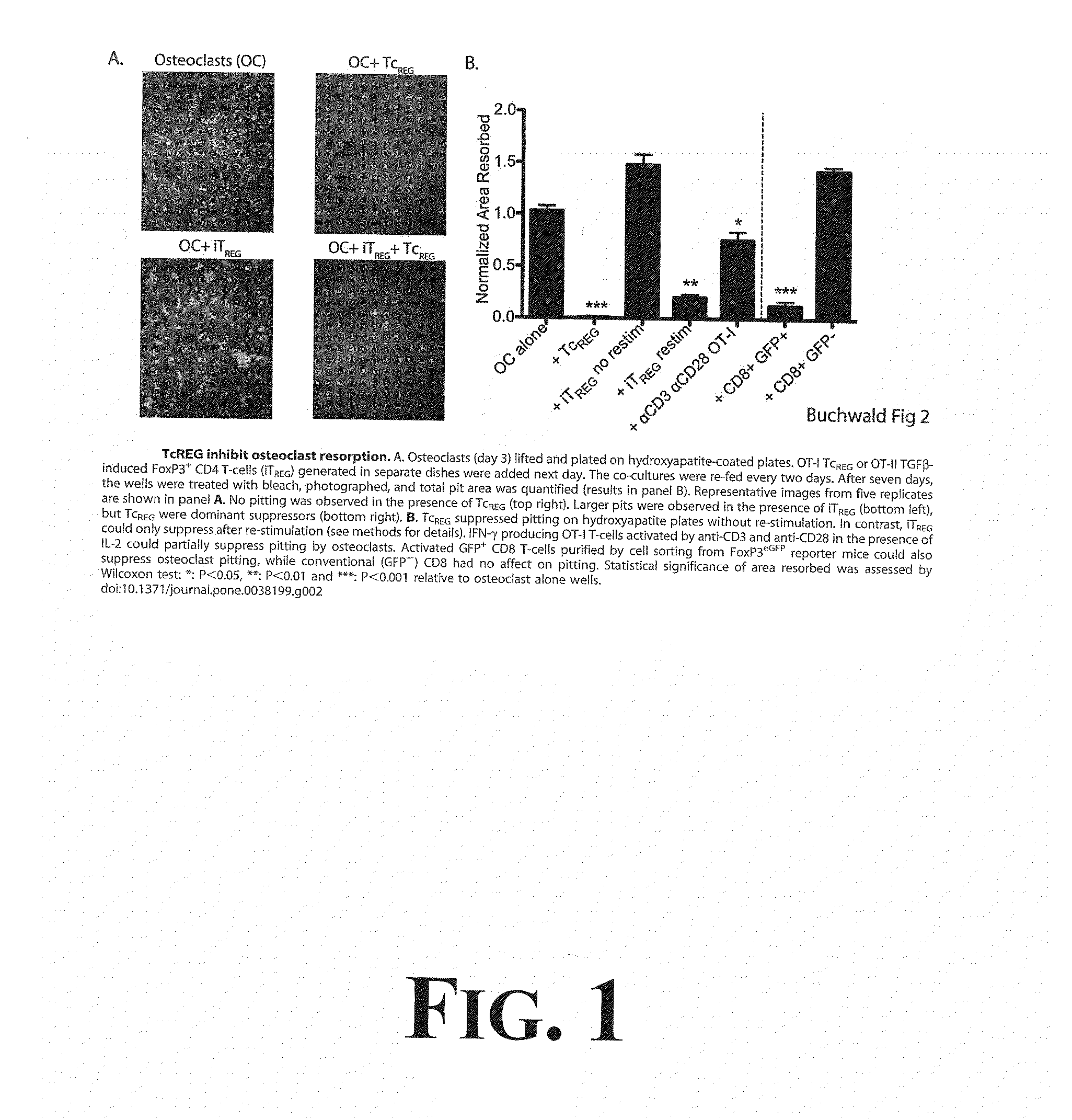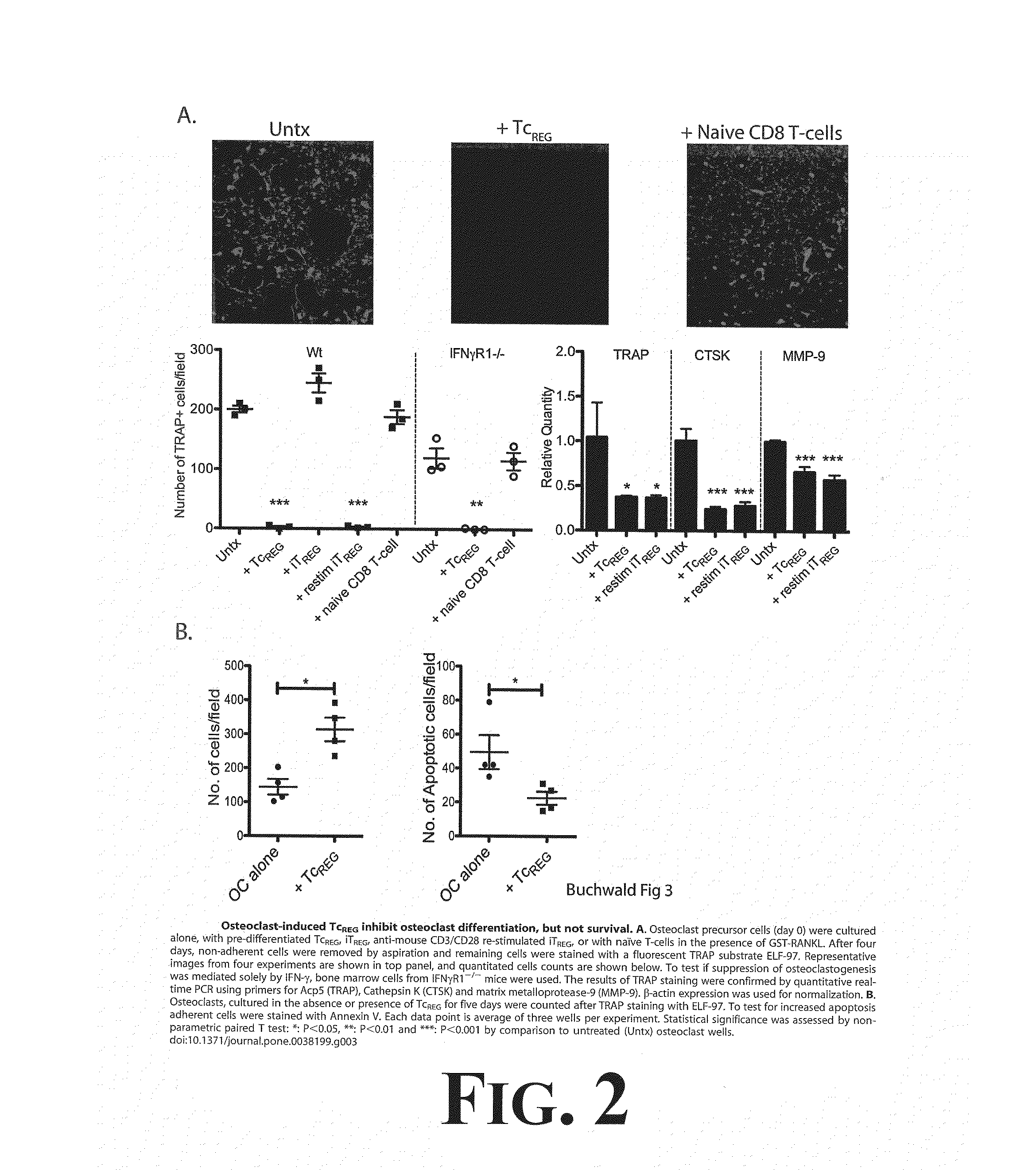Suppression of Bone Loss by Introducing FoxP3+ CD8 T-cells (TcREG)
a technology of foxp3 and cd8 t cells, which is applied in the field of bone loss suppression by introducing foxp3 + cd8 t cells (tcreg), can solve the problems of limiting their use, causing certain problematic conditions, and fragile and brittle bones, so as to reduce bone loss and reduce bone loss
- Summary
- Abstract
- Description
- Claims
- Application Information
AI Technical Summary
Benefits of technology
Problems solved by technology
Method used
Image
Examples
example 1
In vitro Assays
[0042]To determine the effect TcREG secreted cytokines would have on osteoclast activity, experimentation through a number of in vitro assays was undertaken as more fully described in Buchwald, et al., Osteoclast Activated FoxP3+ CD8+ T-cells Suppress Bone Resorption in vitro, PLoS ONE, 7:1-12 (2012), the entire disclosure of which is incorporated herein by reference. The results from this experimentation demonstrated that TcREG secreted cytokines (IL-6, IL-10 and IFN-γ) could suppress osteoclast differentiation and osteoclast resorption. First, it was demonstrated that induction of FoxP3 in CD8 T-cells is antigen dependent; the cytokines are produced by the TcREG (and not the osteoclasts). Second, as demonstrated in FIG. 1, TcREG can suppress osteoclast activity on synthetic bone. For example, results demonstrated that TcREG secreted cytokines could potently and directly suppress resorption by osteoclasts (as demonstrated in FIG. 1). In order to understand how TcREG ...
example 2
Ex Vivo Generated TcREG Tested With RANKL-Administered Mice
[0043]TcREG were generated and adoptively transferred using OT-I transgenic T-cells into an OT-I Rag1− / − mouse to determine if TcREG could suppress bone turnover in vivo under homeostatic conditions. Because the OT-I Rag1− / − mice lack endogenous TcREG and are not lymphopenic, two potential confounding experimental conditions are eliminated. Forty eight (48) hours after the T-cell transfer, the recipient mice were injected with RANKL. RANKL administration was utilized to increase the sensitivity of the assay by activating bone turnover. The bone turnover was assayed by measuring serum carboxyl-terminal collagen telopeptide crosslinks (CTX) ELISA from blood obtained via sub-mandibular bleeds. T-cells activated with anti-CD3 (αCD3) and αCD28 were used as a control since cells activated in this manner produce significant levels of interferon (IFN)-γ. The untreated and control (IFN)-γ producing T-cell treated mice showed a robust...
example 3
Ex Vivo Generated TcREG Tested With Ovariectomized Mice
[0045]To investigate whether TcREG could reduce bone turnover when osteoclast activity is instead increased by a pathological condition, the TcREG in a model of post-menopausal osteoporosis was tested. Experimentation is more fully described in Buchwald, et al., Osteoclast-induced FoxP3 CD8 T-cells Limit Bone Loss in Mice, Bone, 56:163-173 (2013), the entire disclosure of which is incorporated herein by reference. A bilateral ovariectomy of 12 to 14 week old mice was performed. Twenty million TcREG cells were adoptively transferred into ovariectomized (OVX) mice. The adoptive transfer was performed two weeks post-OVX because at this time the osteoclasts were maximally active and the mice already showed significant bone loss. The bone turnover was evaluated by serum CTX using blood samples obtained every five (5) days. As demonstrated in FIG. 5C, while untreated OVX mice or those treated with control T-cells activated by αCD3 plu...
PUM
| Property | Measurement | Unit |
|---|---|---|
| bone structure | aaaaa | aaaaa |
| bone resorption | aaaaa | aaaaa |
| bone strength | aaaaa | aaaaa |
Abstract
Description
Claims
Application Information
 Login to View More
Login to View More - R&D
- Intellectual Property
- Life Sciences
- Materials
- Tech Scout
- Unparalleled Data Quality
- Higher Quality Content
- 60% Fewer Hallucinations
Browse by: Latest US Patents, China's latest patents, Technical Efficacy Thesaurus, Application Domain, Technology Topic, Popular Technical Reports.
© 2025 PatSnap. All rights reserved.Legal|Privacy policy|Modern Slavery Act Transparency Statement|Sitemap|About US| Contact US: help@patsnap.com



